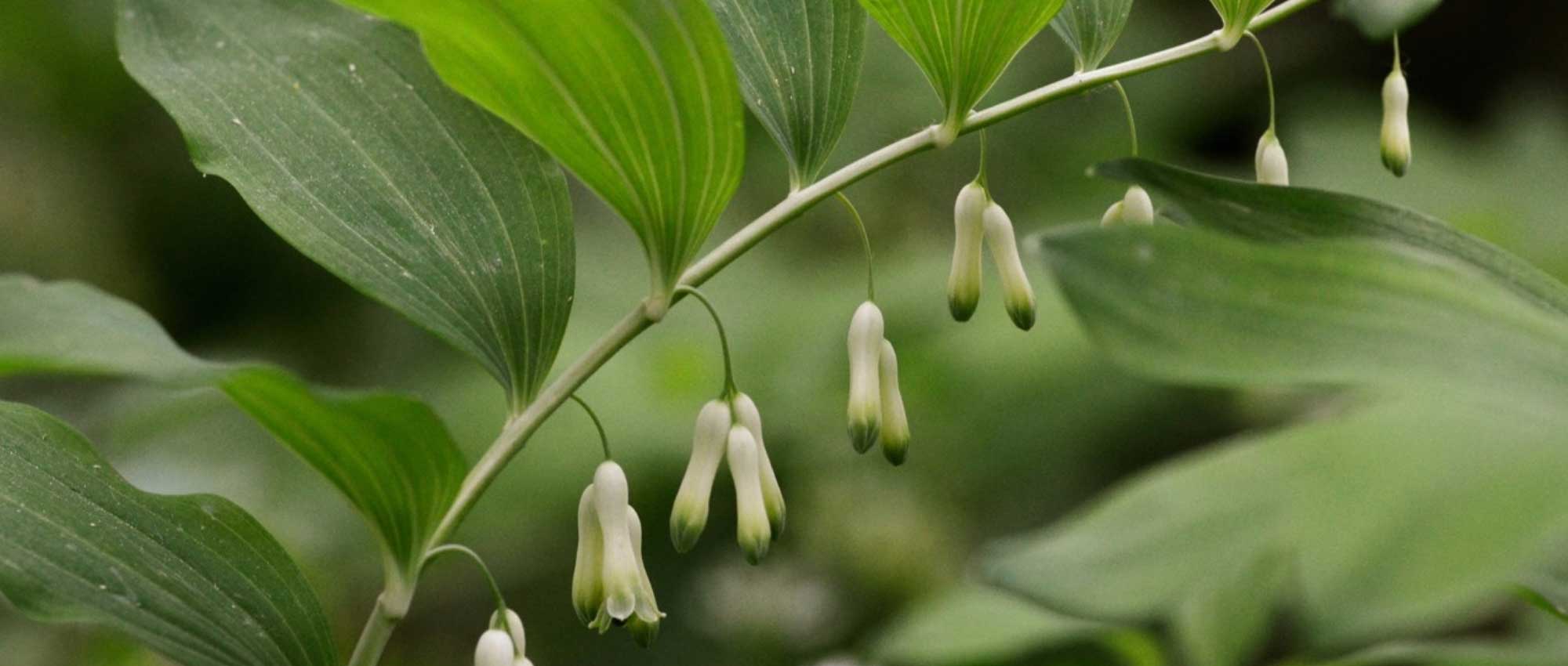
Sceau de Salomon, Polygonatum : planting, dividing and care
Contents
Solomon's Seal in a nutshell
- Solomon’s seal has superb foliage, a beautiful green, sometimes variegated
- Its silhouette is very elegant, nicely arched
- It offers delicate flowering in spring, with small trailing bell-shaped flowers, often white.
- It is an excellent young plant for a shady garden
- It is appreciated for its very natural and wild appearance
A word from our Expert
The Polygonatum, commonly known as Solomon’s Seal, is a perennial plant that features beautiful arching stems, from which small bells, often white, dangle in spring. The foliage is stunning, often ovate and of a superb green hue. There are also some very beautiful varieties with variegated foliage, such as Polygonatum falcatum ‘Variegatum’. With its foliage and flowering white bells, Solomon’s Seal somewhat resembles a large lily of the valley… no surprise there, as it belongs to the same family! The most common species are the multiflorous Solomon’s Seal, Polygonatum multiflorum, and the fragrant Solomon’s Seal, Polygonatum odoratum, two quite similar plants with an elegant and natural style!
An essential plant for shady gardens, Solomon’s Seal is perfect for creating a rather natural area in woodland. It can dress the base of trees, but it also tolerates sun as long as the soil remains cool. It is a hardy plant that does not really require maintenance. When it is happy, Solomon’s Seal spreads in the garden, sometimes forming beautiful colonies…
Botany
Botanical data
- Latin name Polygonatum sp.
- Family Asparagaceae
- Common name Solomon's Seal
- Flowering in May-June, sometimes until July
- Height very variable, but often between 70 cm and 1 m
- Exposure preferably shade or partial shade. Possibly, non-burning sun.
- Soil type cool, humus-bearing, fertile, draining, rather acidic
- Hardiness between -15 and -20 °C
The Solomon’s Seal, or Polygonatum, is a perennial plant with around 70 species, found in temperate regions of the Northern Hemisphere. They are mainly found in Asia (notably in China), as well as in Europe. A few species come from North America (P. biflorum). There are some stunning species native to Asia! Solomon’s Seal is typically a woodland plant; in the wild, it is encountered in forests and forest edges. It thrives in cool, humus-bearing soils.
The most common are Polygonatum odoratum and Polygonatum multiflorum, two species quite common in France. They tend to hybridise, resulting in Polygonatum x hybridum (sometimes referred to as Polygonatum multiflorum, to complicate matters a bit!). In addition to the fragrant and multiflorous Solomon’s Seals, a third species is present in France: Polygonatum verticillatum, easily recognisable by its whorled leaves (several leaves attached at the same level on the stems). As it is found in nature in France, Solomon’s Seal is well adapted to our climate and has excellent hardiness.
Solomon’s Seal is a plant that has often changed botanical families. It is now classified in the Asparagaceae family, the family of Asparagus, along with Agave, Hosta, Lily of the Valley, Muscari, Hyacinth, Ophiopogon… It was previously classified among the Liliaceae (Lilies) and among the Convallariaceae (the former family of Lily of the Valley)… Solomon’s Seal does indeed resemble Lily of the Valley! All these plants are monocotyledons, which explains the parallel veins of their leaves.
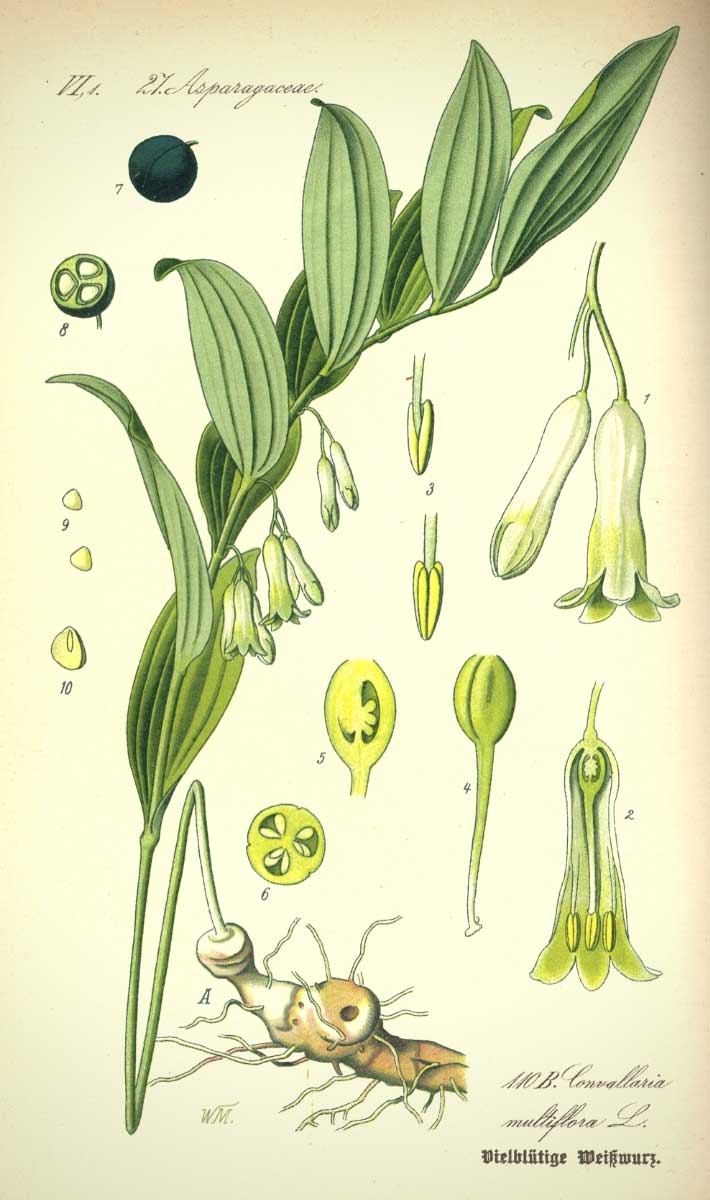
Polygonatum multiflorum: botanical illustration
The name Polygonatum comes from ancient Greek poly: many, and gonu: knees, referring to the numerous swellings of the rhizome. It also owes its vernacular name (Solomon’s Seal) to its rhizomes, on which each old stem leaves a rounded scar resembling a wax seal. Beware of confusion with the genus Polygonum, the knotweeds or persicaries, as well as with the plant Smilacina racemosa, also known as “False Solomon’s Seal”. Its foliage closely resembles that of Solomon’s Seal… But not its flowering!
Polygonatum can take a little time to get started, beginning its growth. They form clumps of upright, leafy stems that emerge from an underground rhizome. If the situation suits it, Solomon’s Seal tends to spread, potentially forming beautiful colonies without becoming invasive. Moreover, it is a long-lived plant!
The stems are initially upright then curved, arched, giving the plant a soft and elegant silhouette. The upper part of the stems is almost horizontal. The stems of Solomon’s Seal are not branched. They can sometimes take on beautiful colours: for example, they are red in Polygonatum ‘Red Stem’. Solomon’s Seals have a very symmetrical appearance, with their leaves evenly distributed on either side of the stem!
The most common Solomon’s Seals, Polygonatum odoratum and P. multiflorum, measure 70 cm to 1 m tall. However, there are also giant species: thus, Polygonatum kingianum can reach up to 2 metres in height! Conversely, other Solomon’s Seals are tiny: Polygonatum hookeri does not exceed 10 cm in height. It is very different from other species: close to the ground, with a sprawling habit and well-opened pink flowers, inclined upwards!
Flowering occurs in spring, often in May-June, sometimes until July.
The plant then bears small white flowers, directed towards the ground, hanging below the stems. They appear in the axil of the leaves and are attached by a fine stem (peduncle). The flowers can be solitary or gathered in pairs or more (rarely more than six flowers), forming small drooping clusters. The flowering is delicate, light, humble, and quite discreet, as the flowers are somewhat hidden by the foliage. The white flowers beautifully highlight the curve of the stems. As regular as the foliage, they add rhythm to the plant.
Most of the time, the flowers are small white bells, tinged with green at the tip of the corolla tube. They can also be pink, as in Polygonatum hookeri. There are also surprising varieties, such as Polygonatum kingianum, which has red flowers marked with green!
The flowers, measuring 1 to 3 cm long, consist of an elongated tube (corresponding to the fused petals and sepals), ending in six small teeth. They can also be much more open, having a completely different appearance, as in Polygonatum hookeri. Inside the tube of the corolla are six stamens, which carry the pollen, and a style. The ovary is located at the bottom of the tube formed by the petals. In most varieties, as the entrance to the flower is not really wide, only insects with a long proboscis can come to consume the nectar and transport pollen from one flower to another.
Although most Solomon’s Seals have simple flowers, there are varieties with double flowers, such as Polygonatum odoratum ‘Flore Pleno’. The flowers then have a few additional rows of petals.
The flowers of Polygonatum odoratum exude a light fragrance.

The flowers of Polygonatum multiflorum. Overview (photo Hamon JP) / Front view and longitudinal section (photos Frank Vincentz)
Solomon’s Seal bears beautiful entire leaves, undivided, and oval in shape. They can also be very fine, as in Polygonatum kingianum. The edge of the lamina is smooth, without teeth, entire. They measure between 5 and 20 cm long – less in the small Polygonatum hookeri. The veins of Solomon’s Seal leaves are parallel, then converge towards the top of the lamina… Just like on Lily of the Valley leaves!
The foliage is alternate and very regular, with leaves inserted in two opposite ranks… This gives the plant a symmetrical and graphic appearance! They can also be whorled (at least three leaves attached at the same level), as in Polygonatum verticillatum. In any case, the leaves are always arranged very regularly, with the same distance between each node (leaf insertion point), the plant seems “rhythmed” by the regularity of its foliage! The leaves are sessile: the lamina is directly attached to the stem, without a petiole.
The leaves have a beautiful green hue. There are also many varieties with variegated foliage, such as Polygonatum falcatum ‘Variegatum’. The variety Polygonatum odoratum ‘Byakko’ has astonishing leaves, white at the base, green at the tip. Variegated varieties are ideal for brightening up a shady corner! The slightly dark areas of the garden will reveal the beauty of their foliage and flowering.
In autumn, the foliage takes on a beautiful golden yellow hue (even more so if you grow a variety like Polygonatum falcatum ‘Variegatum’), before disappearing. Solomon’s Seal is indeed a deciduous plant. It will reappear in spring.

The foliage of Solomon’s Seal. Polygonatum verticillatum (photo Krzysztof Golik), Polygonatum humile (photo Salicyna) and Polygonatum falcatum ‘Variegatum’
Solomon’s Seal has rhizomes, horizontal underground stems that extend over time. They are fleshy, very thick, cream-white in colour, and give rise to much finer roots. It is also from the rhizomes that the aerial, leafy stems develop in spring. At the end of the year, when these disappear, they leave a scar on the rhizome resembling a seal, which is what gives the plant its name!
By mid-summer, decorative fruits replace the flowers: they are spherical berries, usually black or blue-black, sometimes red (as in Polygonatum verticillatum, for example). They often measure between 2 and 6 mm in diameter. The berries are toxic to humans but appreciated by birds!
 The berries of Polygonatum odoratum
The berries of Polygonatum odoratum
Read also
The best hardy geraniums for shadeThe main varieties
The most popular varieties
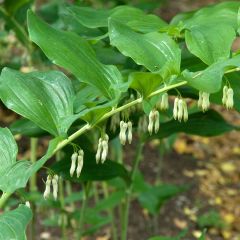
Polygonatum multiflorum - Solomon's Seal
- Flowering time June, July
- Height at maturity 60 cm
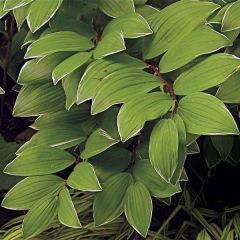
Polygonatum falcatum Variegatum - Solomon's Seal
- Flowering time June, July
- Height at maturity 70 cm
Our favourite varieties
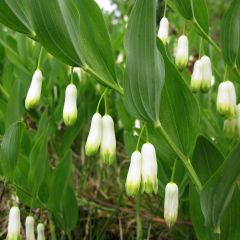
Polygonatum odoratum - Solomon's Seal
- Flowering time June, July
- Height at maturity 40 cm
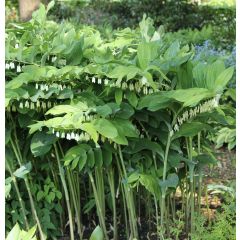
Polygonatum x hybridum Weihenstephan
- Flowering time June, July
- Height at maturity 1 m
Other varieties to discover
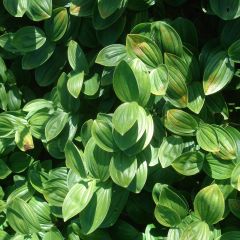
Polygonatum humile
- Flowering time June, July
- Height at maturity 15 cm
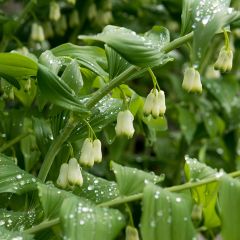
Polygonatum commutatum - Solomon's Seal
- Flowering time June, July
- Height at maturity 90 cm
Discover other Polygonatum - Solomon's Seal
View all →Available in 1 sizes
Available in 1 sizes
Available in 2 sizes
Available in 1 sizes
Available in 1 sizes
Available in 1 sizes
Young plantation
Where to plant Solomon’s Seal?
A true woodland plant, Solomon’s Seal thrives in shade or partial shade, under good light conditions. You can place it at the base of trees and bushes, or just in front of a hedge, especially since it tolerates root competition very well! However, it can also tolerate sunlight, but avoid scorching situations! Prefer shade if you are in a Mediterranean region, while you can place it in the sun if you live in northern France.
Solomon’s Seal prefers soil that remains cool (especially if it is in the sun), but at the same time is quite well-draining, as the rhizome does not like excess moisture. However, Polygonatum also adapts very well to dry shade situations!
The soil should be fertile, with a substrate rich in humus, and preferably loose and light. The ideal type is woodland soil. It will appreciate additions of compost, at least at the time of planting. Solomon’s Seal thrives in acidic substrates.
You can install it in a fairly natural area of the garden, where you intervene little. Solomon’s Seals can also be integrated into a cool, shaded rockery. Compact varieties (Polygonatum hookeri…) are the most suitable for this use. Finally, it is also possible to grow them in pots. Just be careful to ensure that the potting soil does not dry out.
If you find it a spot where it is happy, Solomon’s Seal will spread to form a beautiful colony.
When to plant?
You can plant Solomon’s Seal in spring, around April, or in autumn (September-October).
How to plant?
Maintain a distance of about 40 cm between two plants (to be adjusted according to the variety, which may be larger or smaller).
- Start by working the soil to loosen it, remove weeds, and add some compost.
- Dig a planting hole that should be two to three times the size of the root ball.
- Plant your Polygonatum, ensuring that the collar is level with the soil.
- Replace the soil around it, then firm it down with the palm of your hand to ensure good contact between the substrate and the roots.
- Water thoroughly.
Water regularly in the weeks following planting. We recommend applying organic mulch (dead leaves, wood chips…).
Read also
Uvularia: planting, growing and careCare of Solomon's Seal
Caring for Solomon’s Seal is quite limited. However, do not hesitate to water if necessary; it is preferable for the soil to remain nice and moist (especially if the plant is positioned in the sun!). Solomon’s Seal is sensitive to hot, dry summers. We recommend applying a mulch, preferably organic, to keep the soil cool for longer. This will also prevent “weeds” from developing while providing organic matter that will decompose and enrich the soil.
Being quite hardy, Solomon’s Seal does not need to be protected from the cold in winter. You may optionally add some compost or crushed horn at the beginning of spring to enrich the soil. Incorporate it into the soil with a light raking. We also suggest cutting back the plant by trimming its aerial parts at the end of autumn.
Beware of slugs and snails that enjoy nibbling on young shoots in spring. To protect your plants, you can use slug pellets (Ferramol), spread sawdust to create a barrier, or make a slug trap.
You may also encounter issues with sawflies (Phymatocera aterrima). Their larvae, resembling caterpillars, devour the leaves of the plant! Generally, they consume the lamina between the veins, leaving only the main veins…
Solomon’s Seal is rarely affected by diseases. However, be cautious of excess moisture, which could cause the rootstock to rot!

Sawflies devouring the foliage of Solomon’s Seal (photo Pixeltoo / photo Walter Baxter – Solomon’s Seal Sawfly larvae – CC BY-SA 2.0)
Propagating: the division of rootstocks
The best technique for multiplying Solomon’s Seal is by dividing rootstocks. Sowing is also possible, but seeds can take a very long time to germinate… up to two years!
Division of Rootstocks
Solomon’s Seal naturally tends to spread through its rootstocks. You can easily multiply it by taking fragments. Just wait until the plant is a few years old and has developed well before dividing it. Preferably do this in early spring.
- Dig up a rootstock. Be careful not to damage the young shoots, which are particularly fragile.
- Clean it if necessary to remove excess soil.
- Cut the rootstock into several sections, ensuring that each one has at least one bud on top. Use a sharp knife.
- Prepare the ground and immediately place the fragments in the soil. You can also pot them and then plant them in the ground in autumn.
- Water generously.
Make sure to keep the substrate moist (but not overly so!) by watering regularly until the new plants develop.
Pairing Polygonatum in the garden
Solomon’s Seal is an essential plant for woodland gardens or shady gardens, with a very natural style. It pairs perfectly with the stunning white flowers of the Anemone sylvestris, as well as with lily of the valley, a plant that is quite aesthetically close to it. Add subtle touches of colour with Geranium nodosum, the delicate flowering of Epimediums, and that of Dicentra (Bleeding Heart). You can plant ground-covering plants around it, such as periwinkle. Also discover the Dodecatheon, also known as shooting star, a small, very graceful perennial with pink flowers! Enjoy the spring bulbs, especially those that naturalise easily, like the Wood Hyacinth! You will feel as if you are walking through a natural forest, just a bit more floral!
Whether in woodland or in a border, you can combine variegated Solomon’s Seals with other decorative foliage: brunneras, hostas, heucheras, lady’s mantle… Also discover the large palmate leaves of Rodgersia. For ferns, choose Dryopteris, Polystichum or Matteuccia. Add some decorative grasses, such as Luzula, Carex, and Hakonechloa.
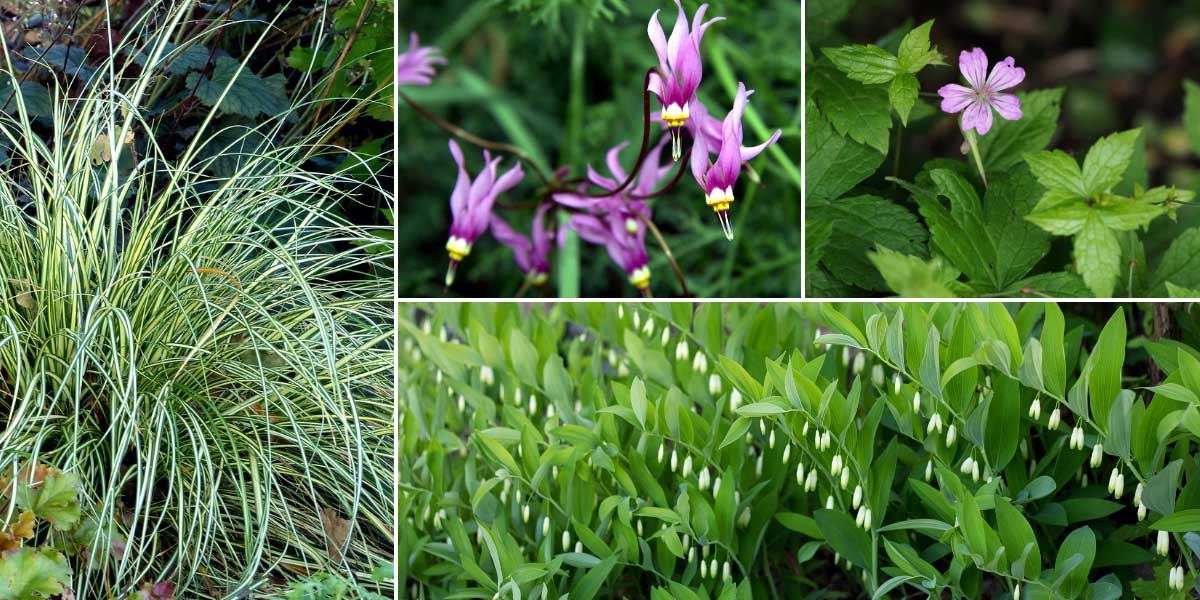
Solomon’s Seal easily finds its place in a shaded garden, with decorative foliage and delicately flowering perennials. Here, Carex oshimensis ‘Evergold’, Dodecatheon conjugens (photo C. T. Johansson), Geranium nodosum, and Polygonatum odoratum (photo oona rälsanen)
Because it has a very elegant and understated appearance, with its arching stems, graceful foliage, and white flowers, Solomon’s Seal can easily fit into a graphic, very contemporary garden, with clean lines. You can place it in a courtyard or patio, and pair it with hostas, ophiopogons, and Acer palmatum. Also enjoy the decorative foliage of heucheras, and the airy flowering of Tiarella! It can also be associated with the surprising flowering of Arisaema. Solomon’s Seal is a very elegant plant, especially if you grow a variety like Polygonatum falcatum ‘Variegatum’. It will add a lot of style and originality to your border. It also pairs well with Maianthemum, a plant from the same family that it resembles a bit!
Solomon’s Seal can also be planted at the foot of spring-flowering shrubs. As it copes well with root competition, you can place it just in front of a wild hedge. For example, pair it with Deutzia, Spiraea, Philadelphus, Viburnum plicatum… Finally, Solomon’s Seal can also be placed under deciduous trees. It will benefit from good light in winter, but the tree leaves will protect it from heat in summer!
Did you know?
- Medicinal properties
Solomon’s Seal is also a medicinal plant: it has tonic, soothing, antipyretic properties, and may help combat diabetes and hyperglycaemia… It can also be used externally for bruises and contusions, to accelerate healing and tissue repair. The rootstock is used in Chinese medicine, under the name Huang Jing or Rhizoma poligonati. Do not use Solomon’s Seal without the advice of a healthcare professional, as this plant is quite toxic in its own right.
- Polygonatum odoratum or multiflorum?
These two species are often confused, as they are quite similar! Polygonatum odoratum has an angular stem, with solitary or paired flowers, while Polygonatum multiflorum has a circular stem section, and its flowers are gathered in larger clusters, with each cluster containing two to six flowers. These are also smaller.
Useful resources
- Discover our range of Solomon’s Seals!
- Francis Peeters talks to us about Polygonatum verticillatum ‘Giant One’
- To accompany the Solomon’s Seal, our selection of shade-loving perennials
- Discover our ideas for pairing with Solomon’s Seals
Frequently asked questions
-
The foliage of my Solomon's seal seems to be nibbled... Why?
The culprits are undoubtedly slugs, which particularly enjoy devouring young leaves in spring! You can create a slug trap, spread fine sand or ash around your plants to create a barrier, or use slug pellets, such as Ferramol. It is also possible that the leaves are being chewed by sawflies – hymenopterans whose larvae resemble caterpillars. Often, only the main veins are left visible, the rest of the lamina having been devoured! The plant is then weakened and declines... Look for the larvae to ensure that they are indeed the cause. Remove the most affected stems and leaves, collect and eliminate the larvae (if they are not too numerous), and then spray a solution based on black soap.
-
Can I plant Solomon's seal in the sun?
Yes, if the soil remains cool and you do not live in a Mediterranean region. It is especially important to avoid scorching sun and drying out of the substrate. We recommend applying mulch and watering regularly if necessary.
- Subscribe!
- Contents
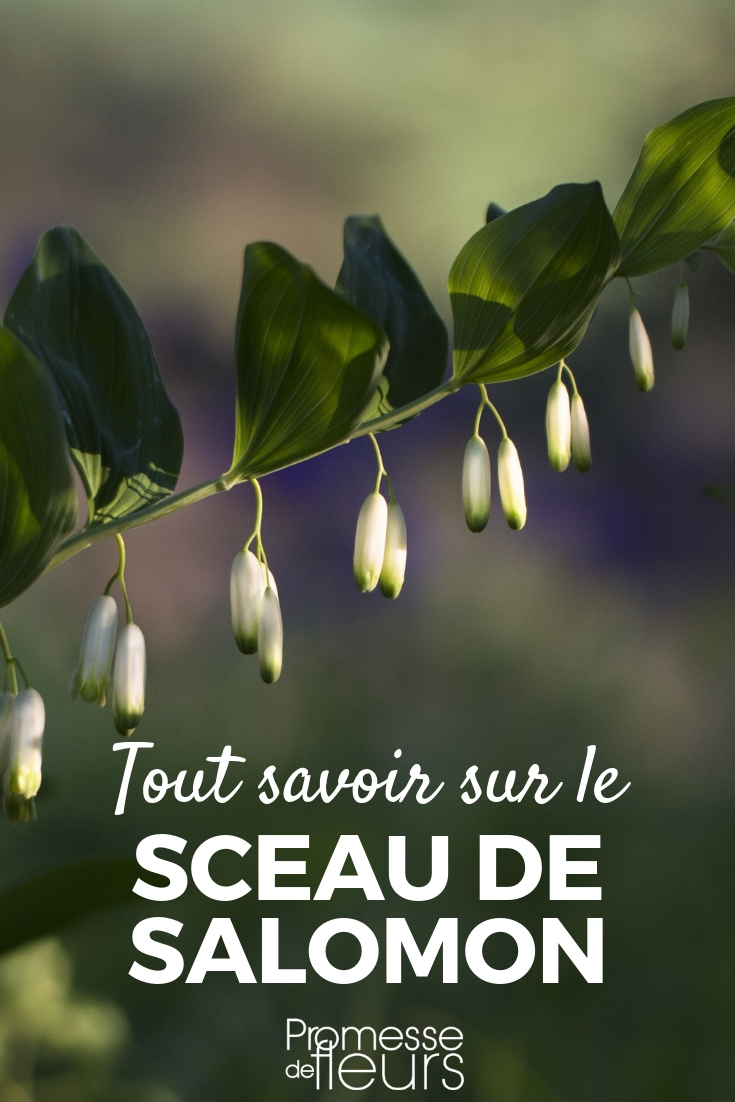





































Comments